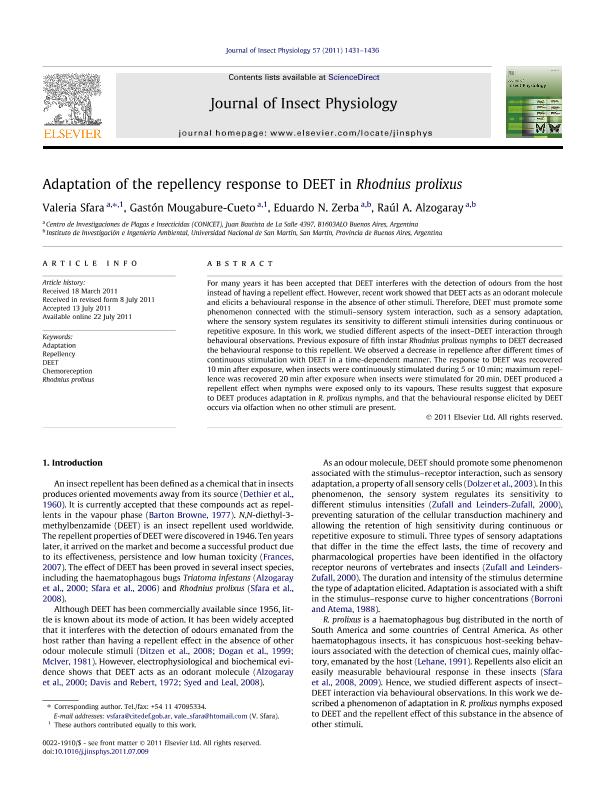Artículo
Adaptation of the repellency response to DEET in rhodnius prolixus
Fecha de publicación:
10/2011
Editorial:
Pergamon-Elsevier Science Ltd
Revista:
Journal of Insect Physiology
ISSN:
0022-1910
Idioma:
Inglés
Tipo de recurso:
Artículo publicado
Clasificación temática:
Resumen
For many years it has been accepted that DEET interferes with the detection of odours from the host instead of having a repellent effect. However, recent work showed that DEET acts as an odorant molecule and elicits a behavioural response in the absence of other stimuli. Therefore, DEET must promote some phenomenon connected with the stimuli-sensory system interaction, such as a sensory adaptation, where the sensory system regulates its sensitivity to different stimuli intensities during continuous or repetitive exposure. In this work, we studied different aspects of the insect-DEET interaction through behavioural observations. Previous exposure of fifth instar Rhodnius prolixus nymphs to DEET decreased the behavioural response to this repellent. We observed a decrease in repellence after different times of continuous stimulation with DEET in a time-dependent manner. The response to DEET was recovered 10. min after exposure, when insects were continuously stimulated during 5 or 10. min; maximum repellence was recovered 20. min after exposure when insects were stimulated for 20. min. DEET produced a repellent effect when nymphs were exposed only to its vapours. These results suggest that exposure to DEET produces adaptation in R. prolixus nymphs, and that the behavioural response elicited by DEET occurs via olfaction when no other stimuli are present.
Palabras clave:
Adaptation
,
Chemoreception
,
Deet
,
Repellency
,
Rhodnius Prolixus
Archivos asociados
Licencia
Identificadores
Colecciones
Articulos(UNIDEF)
Articulos de UNIDAD DE INVESTIGACION Y DESARROLLO ESTRATEGICOS PARA LA DEFENSA
Articulos de UNIDAD DE INVESTIGACION Y DESARROLLO ESTRATEGICOS PARA LA DEFENSA
Citación
Sfara, Valeria; Mougabure Cueto, Gastón Adolfo; Zerba, Eduardo Nicolás; Alzogaray, Raúl Adolfo; Adaptation of the repellency response to DEET in rhodnius prolixus; Pergamon-Elsevier Science Ltd; Journal of Insect Physiology; 57; 10; 10-2011; 1431-1436
Compartir
Altmétricas




